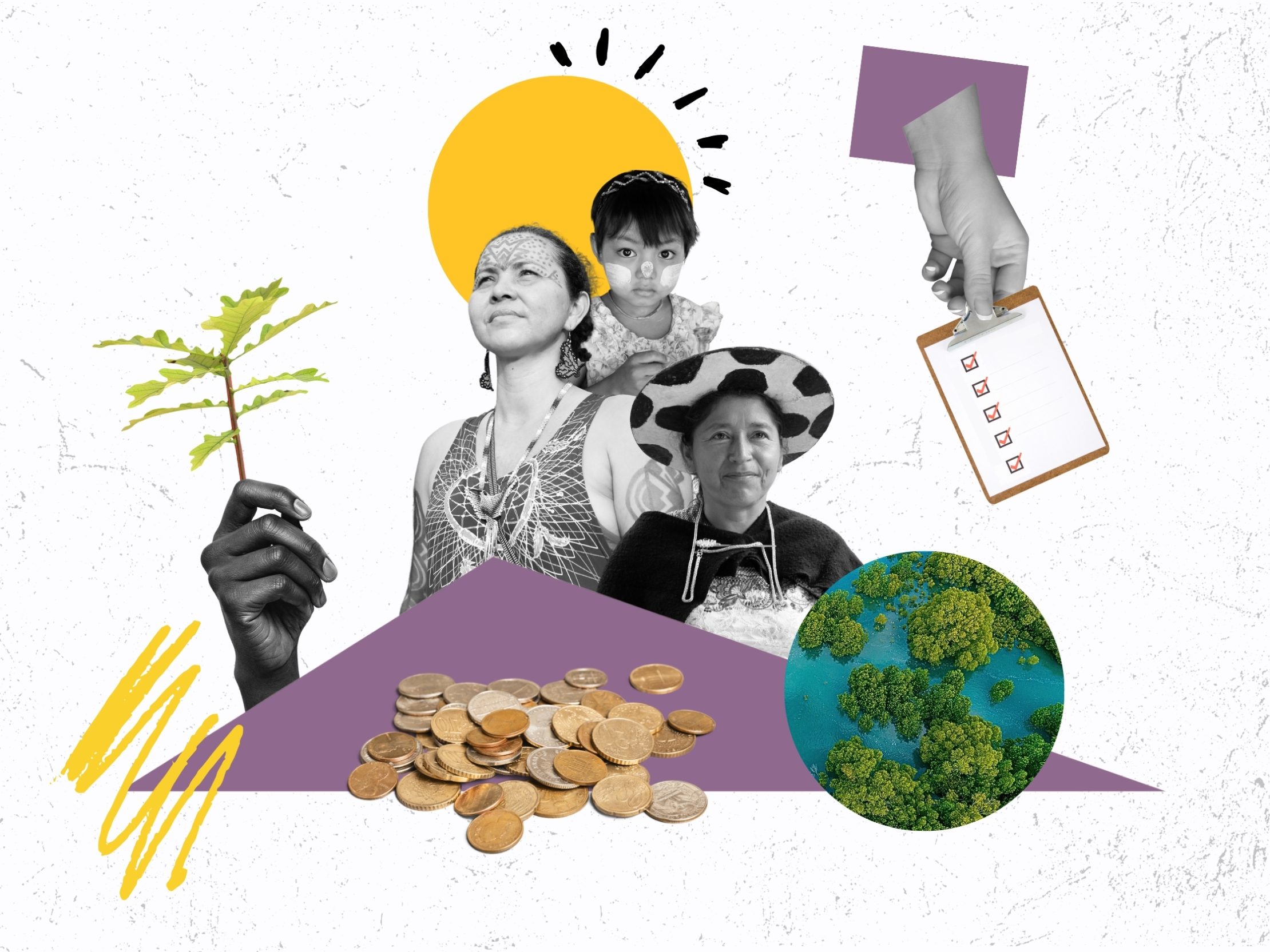
Summary
- Performance-based climate finance refers to funding mechanisms that tie the flow of financial resources directly to the achievement of specific, measurable and verified climate results.
- Performance-based climate finance enhances transparency, accountability and efficiency in the use of climate finance.
- There are two broad categories of performance-based climate finance: market-based approaches, such as carbon markets, and non-market-based approaches, such as sustainability-linked bonds and REDD+ results-based payments.
- Making performance-based climate finance work effectively relies on adequately quantifying results, finding upfront funding to achieve and measure these results, managing financial flows and developing strong policies.
- Building strong institutions and governance frameworks, providing training and support on different funding mechanisms and ensuring equity are critical to the success of performance-based climate finance.
What is performance-based climate finance?
Performance-based climate finance refers to funding mechanisms that tie the flow of financial resources directly to the achievement of specific, measurable and independently verified climate results. Stakeholders who deliver these results receive payments or incentives proportionate to results achieved, creating a results-driven model. This approach is reshaping how climate action is funded because rather than funding intentions, it rewards outcomes. In the urgent global race to address climate change, performance-based climate finance is a promising option, enhancing transparency, accountability and efficiency in the allocation of climate funds.
There are two broad categories of performance-based climate finance:
- Market-based approaches work like a marketplace where climate results – such as reduced greenhouse gas emissions – are bought and sold through the transaction of assets that represent these results. This means that financial support is directly linked to verified climate benefits that can be traded.
- Non-market-based approaches, by contrast, involve providing payments, compensation or economic rewards to encourage continuous climate action. These approaches function as incentive-based policies that complement and reinforce government rules and regulations, collectively aiming to enhance environmental performance.
For performance-based climate finance to work, all involved stakeholders must have strong measurement, reporting and verification (MRV) systems in place to accurately track progress and results. Independent verification of results is a cornerstone to ensure credibility.
Why does performance-based climate finance matter?
Performance-based climate finance links flows of finance directly to verified climate change mitigation results. This clear connection between funding and outcomes increases transparency, which in turn builds trust among all stakeholders involved – from governments and donors to frontline communities working on climate action.
Performance-based climate finance also sparks innovation. Since finance depends on the achievement of results, implementers are keen to find the most effective and efficient ways to deliver impact. This results-focused approach encourages a culture of learning and continuous improvement, which strengthens the long-term success and sustainability of climate initiatives.
Moreover, it sharpens attention to building strong institutions that are responsible for tracking and achieving long-term sustainability of these results. By rewarding measurable progress, performance-based climate finance supports countries in meeting their goals under the Paris Agreement, helping turn their Nationally Determined Contributions (NDCs) from commitments into real action. This approach fosters greater national ownership while reinforcing institutional frameworks – improving management, strengthening accountability and actively engaging stakeholders, such as subnational governments, Indigenous Peoples and local communities. They become co-responsible for delivering results, which opens new pathways for them to access climate finance as well.
Finally, performance-based climate finance appeals to the private sector. Its emphasis on clear, measurable outcomes and transparent reporting lowers investment risks, encourages more private investment, and boosts overall flows.

Costa Rica reinvests REDD+ results-based payments into its Payment for Environmental Services programme, including direct funding to Indigenous territories - ensuring equitable access to climate finance and protecting biodiversity. Photo: UNDP Costa Rica

In Ecuador, results-based payments are restoring degraded forest lands and promoting sustainable, deforestation-free production systems – demonstrating how climate finance can drive both conservation and resilient livelihoods. Photo: PROAmazonia
How do performance-based climate finance mechanisms work?
In performance-based climate finance, success is measured using metrics that reflect actual progress toward climate change mitigation or adaptation goals.
For mitigation, performance is typically assessed by the verified reduction, avoidance or removal of greenhouse gas emissions, measured in tonnes of carbon dioxide equivalent (CO2e) – a unit of measurement that is used to standardise the climate effects of various greenhouse gases. Depending on the sector, other complementary metrics – such as adherence to social and environmental safeguards – may also be used.
For adaptation, establishing a performance-based finance scheme is more challenging due to the inherent difficulty in measuring performance on resilience. However, initiatives like the Systematic Observations Financing Facility, are already applying performance-based finance, where developing countries will receive financing upon the verification of real time transmission of weather data. Similarly, the ongoing discussion on the Global Goal on Adaptation, where common indicators for measuring progress on adaptation are being defined, can contribute to improving the enabling conditions toward performance-based finance in adaptation in the future.
One prominent example of a market-based performance finance mechanism are carbon markets. These markets allow for verified mitigation outcomes to be turned into carbon credits that can be bought and sold, creating a financial incentive for climate action. There are two main types of carbon markets: regulated and voluntary. Regulated carbon markets, such as the EU Emissions Trading System or the cooperative approaches under Article 6 of the Paris Agreement operate under formal rules and regulations set by governments. Voluntary carbon markets rely on independent standards, which define how to measure and account for climate outcomes. These rules and standards cover everything from methodologies and carbon accounting to environmental and social safeguards.
Examples of non-market-based performance finance include sustainability-linked bonds and REDD+ results-based payments (RBPs). Sustainability-linked bonds have gained popularity in recent years. These bonds include climate targets and achieving them can trigger financial incentives – such as reduced interest rates for debt holders. The bond’s design and structure outlines both the climate performance criteria and the financial terms linked to them. Bilateral and multilateral agreements under performance-based finance work similarly. Governments agree on specific conditions for funding disbursement, along with methods to measure performance, often aligned with multilateral agreements such as those under the United Nations Framework Convention on Climate Change (UNFCCC), or other provisions like the accomplishment of climate policy milestones as a trigger of finance under bilateral agreements.
REDD+ RBPs directly link finance to emission reductions from deforestation and forest degradation. Two major initiatives in this space are the Forest Carbon Partnership Facility´s Carbon Fund and the REDD+ results-based payments pilot programme under the Green Climate Fund (GCF). The latter was launched in 2017 and has to date allocated US$500 million to countries that demonstrate emission reductions or removals, as established under the UNFCCC REDD+ framework, and meet GCF´s eligibility criteria.

The Amazon rainforest plays a critical role in regulating the global climate. Performance-based climate finance supports efforts in Brazil to protect this vital ecosystem, ensuring it continues to store carbon, safeguard biodiversity and sustain communities. Photo: Leonardo Dall’Igna / UNDP Brazil

Through South-South cooperation, the Democratic Republic of Congo is strengthening its systems to access results-based climate finance – supporting forest protection efforts while promoting inclusive climate governance. Photo: UNDP Democratic Republic of Congo
What are some of the challenges in accessing performance-based climate finance?
While performance-based finance offers powerful incentives for climate action, it also comes with several challenges:
The most important hurdle is the need for upfront funding. Because payments are only made after results are fully measured and independently verified, implementers must secure initial financing to undertake the activities that lead to these results. This can be a significant barrier, especially for stakeholders and countries with limited access to capital, potentially excluding local communities or smaller organizations.
Measuring real climate outcomes isn’t always straightforward. Achieving impact is one thing – proving it is another. Here is where MRV systems and independent verification come into play. Setting up MRV systems requires technical expertise and investment. The verification of results involves coordinating diverse stakeholders, agreeing and understanding the methodologies, and navigating language and cultural differences.
Performance-based climate finance can bring large funding flows; but without strong policies and institutions managing these resources effectively can be challenging.
Although robust methods exist to track mitigation performance, the variety of standards across funding sources – especially between market and non-market approaches – adds complexity. For example, carbon markets can bring extra challenges, like the variety of rules across different standards, or by including requirements like clarity about carbon rights.
How can these challenges be addressed?
To make performance-based climate finance more effective and inclusive, thoughtful design and strategic support are essential. Many of the core challenges – like tracking outcomes or managing funding flows – can be addressed by strengthening the institutions that implement these programs. This includes improving MRV systems, clear rules for managing funds, enhancing data-sharing across agencies, and building strong governance frameworks, among others.
Furthermore, capacity building can help countries navigate the different standards and methods used across funding sources, making it easier to access multiple types of funding. For instance, by linking carbon market readiness with national MRV and safeguards systems, countries can simultaneously access both market-based and non-market-based sources of finance – without compromising environmental or social integrity.
Solving the need for upfront funding can be done by combining flexible tools like grants, loans and milestone payments to ease early costs, especially where resources are tight.
Ensuring equity is another critical factor. For performance-based systems to be truly effective, they must accommodate a wide range of interventions and financial flows that ensure marginalized groups – such as women, youth and Indigenous Peoples – can participate meaningfully and benefit fairly. As such, financial mechanisms need to be tailored to provide equitable access to diverse stakeholders. This is not only a matter of justice; it also enhances the reach, sustainability and legitimacy of climate action on the ground.

In the heart of the Amazon, Brazil’s Floresta+ programme supports Indigenous Peoples, traditional communities and smallholder farmers by linking financial rewards to proven environmental stewardship. Photo: Dheimison Logan

Indonesia channels REDD+ finance through its Environment Fund to support its Forest and Other Land Use Net Sink 2030 strategy – showcasing national leadership in performance-based climate finance implementation. Photo: Roy Prasetyo / UNDP Indonesia
What role does UNDP play in supporting performance-based climate finance?
UNDP is a key enabler of performance-based climate finance worldwide, with extensive experience on climate mitigation in the forestry and land use sector. Its role spans technical assistance, policy development, project implementation and global knowledge exchange, delivered mostly as a partner of the UN-REDD Programme.
On the technical side, UNDP helps countries to meet the eligibility criteria of financiers and strengthen the institutional capacities needed to participate in performance-based climate finance.
UNDP also focuses on promoting transparency, ensuring environmental and social safeguards, and creating fair benefit-sharing systems in all performance-based climate finance mechanisms, including carbon markets.
To foster high integrity across all types of carbon markets, UNDP launched its High Integrity Carbon Markets Initiative. UNDP supports countries in accessing and implementing high-integrity carbon markets by providing strategic support across both readiness and implementation phases. This includes assistance with Article 6 cooperation, international voluntary carbon markets, and domestic compliance schemes. UNDP’s work is grounded in environmental and social safeguards, transparency, and equitable benefit-sharing, ensuring that carbon finance aligns with national climate goals and contributes meaningfully to the Sustainable Development Goals (SDGs).
In terms of policy, UNDP works with governments to align performance-based climate finance with national strategies. In Indonesia for instance, this meant helping to channel REDD+ finance into the Environment Fund in support of the Forest and Other Land Use Net Sink 2030 strategy.
At the same time, UNDP assists countries in the implementation of resources achieved via results-based finance, namely REDD+ RBPs. UNDP´s own Performance-Based Payment instrument has been a game-changer, enabling the rapid disbursement of RBPs.
In Costa Rica, RBPs are being reinvested into the country’s Payment for Environmental Services programme – including through a new modality that directly channels funding to Indigenous territories.
In Ecuador, RBP funds are directed toward restoring degraded forest lands and promoting sustainable production, directly supporting Ecuador’s climate targets while improving land use practices. It also strengthens efforts to transition toward deforestation-free production systems, linking climate finance with sustainable supply chains and long-term forest conservation.
In Brazil, the RBP-funded Floresta+ programme is incentivizing environmental services provided by smallholder farmers, traditional communities and Indigenous Peoples in the Amazon. By linking financial rewards to verified environmental stewardship, the programme advances both climate goals and local development.
UNDP also serves as a hub for knowledge sharing on climate finance for forest action, including performance-based finance. A recent South-South exchange, initiated by UNDP and hosted by Indonesia, brought together Indonesia, Brazil, Ecuador, Cambodia, Costa Rica and the Democratic Republic of Congo to share experiences and strengthen cooperation on REDD+ and results-based climate finance, helping countries learn from one another and adapt approaches to fit their unique needs.